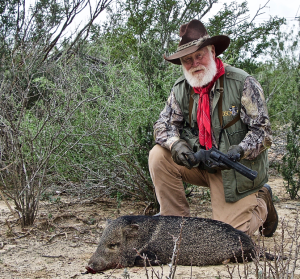 It was February 1984. Judd Cooney, former Colorado Game Warden, outdoor writer, outfitter, photographer extraordinaire, and I were headed to attempt to call and photograph coyotes on the Chaparral Wildlife Management Area southwest of Cotulla, Texas. On our way Judd and I had talked about many topics including calling black bear when he asked, “You ever called in a javelina?” knowing I had spent considerable time in the Brush Country of South Texas as a wildlife biologist but also as a serious hunter, and someone who was very seldom without a Burnham Brothers C3 mouth-blown predator call.
It was February 1984. Judd Cooney, former Colorado Game Warden, outdoor writer, outfitter, photographer extraordinaire, and I were headed to attempt to call and photograph coyotes on the Chaparral Wildlife Management Area southwest of Cotulla, Texas. On our way Judd and I had talked about many topics including calling black bear when he asked, “You ever called in a javelina?” knowing I had spent considerable time in the Brush Country of South Texas as a wildlife biologist but also as a serious hunter, and someone who was very seldom without a Burnham Brothers C3 mouth-blown predator call.
“Yes Sir I have, but only twice once I was calling coyotes and another time when I was hunting in Mexico chasing whitetails. In each instance they came running in, not unlike a hungry coyote.” I hesitated the added, “Why do you ask, you interested in doing so. I can tell you there are a lot of javelinas on the Chap!” Judd nodded approvingly.
We had driven merely two more miles when a herd of about twenty javelinas ran across the road in front of us. We had scarcely passed where they had disappeared into the brush when “Pull over! Let’s see if we can get those javelina to respond to a call!” I did as instructed, after telling Judd we could not not shoot one where we were even though I had permission to hunt on the north side of the highway. “Let’s just get photos if they do come back.”
As I was stepping out call in hand, “Call to them like I told you to call to a black bear and see if that works.” Judd’s way of saying when you start blowing, make as much noise on the call as possible and don’t quit blowing for several minutes. During earlier discussions about calling black bear with a regular predator call he told me he had determined as long as you constantly and continually kept blowing on the call the bear kept coming. If you quit the bear lost interest and quit coming.
I started blowing, loudly! I kept blowing for a full minute before we got any response. Then here came the entire herd; boars, sows even little piglets squealing loudly, making loud popping noises with there jaws, back bristles “standing on end”, charging directly toward us!
As they came closer I stepped into the pickup, window open and kept blowing as loudly as possible. Judd madly took pictures, this back before digital cameras when we used 35 mm, film cameras.
“Out of film… Don’t quit calling! Want more pictures!” urged my Colorado friend. Keeping blowing on my predator call seemed easy, if you were not doing it! My lips and cheek muscles started cramping, and breaths were coming a lot more difficultly than when I had started. I did my best.
Javelinas, highly agitated and aggressive javelinas, circled our pickup getting so close even Judd got into the cab. When he did I quit blowing my call. The little desert false-pigs lost interest and started drifting away.
“Interesting!” proclaimed Judd. “A warden friend of mine from Arizona told me he’s been calling javelinas, just like I do when calling black bear. It really does work!” Indeed, it had worked! I could not wait to try to call another herd of the unique dwellers of the deserts of the Southwest.
Before our coyote calling-photography trip was over we called in two more herds and one lone, ancient boar. All responded the same way; charging in, back bristles standing on end, squealing, teeth popping…looking for a fight!
A couple of months later I decided to take my daughters Theresa and Beth to a ranch north of Laredo, just above the Texas and Mexico border where I had permission to hunt for deer, javelina, predators and Indian artifacts. At the time neither daughter had shot a javelina.
Initially I thought about trying to call javelina, properly called collared peccary, for my daughter and have them shoot one. But then thought it would probably be a better idea to spot and stalk, thereby having a standing rather than a running target. Calling javelinas they were never standing still, always running.
Spot and stalk it would be. After they had shot their javelinas I would put them on the back of my pickup where they and I would be safe, and call.
It took a day and a half to find two herds of javelina. Theresa shot first and put down a nicely toothed boar with one shot from my 7×57 shooting Hornady’s 139-grain PSP ammo (www.hornady.com). An hour later we found another herd that we were able to get downwind of and stalk to within less than 50-yards. There from a fork in a mesquite tree rest, Beth shot an equally big boar with the same 7×57. Two boars down. A short time later we hung both in the shed for the vaquero and his family who lived on the ranch and had requested we shoot two javelinas for them. Chore done, I decided to see if we could call in some collared peccaries.
Toward the northeast corner of the expansive ranch was a wide brushy draw that lead to a sizable stock tank (pond for those of you not from Texas). I had previously, numerous times, seen javelinas in the area.
I parked my pickup where we could see the backside of the tank and a “green open area” where the water had receded. I started calling loud as possible, not stopping. Five seconds into my call javelinas started running out of the brush coming our way, teeth popping, squealing; sows, boars, near fully grown pigs on down to what looked like day old piglets, all doing the same. They charged directly at the pickup where I sat on the back with both daughters, who were now wide-eyed and slack-jawed, staring in amazement at the rapidly coming javelinas, which ran circles around the vehicle loudly popping their jaws!
I called for another minute as both daughters watched in amazement, but also now closely huddled next to me. When I quit calling the excited and agitated javelinas drifted away.
It was a couple of years before I again got serious about calling javelina. But again, they responded as I had hoped and expected.
Over the years that followed I called in javelinas in several Mexican states and throughout southern and western Texas, often to the total amazement of those with me, but also thankful I had positioned them in the back of vehicle, a raised deer blind or five to six feet above the ground and the javelinas in a tree.
My last attempt at calling javelina was a couple of years ago not far from the Texas and Mexico border. I was hunting with a Taurus Raging Hunter (www.taurususa.com)n.454 Casull, shooting Hornady’s 300-grain Custom ammo.
After finding an area where javelinas had been feeding on their primary food, prickly pear cactus, evidenced by several near totally and partially eaten pads. Interestingly, javelina can only chew up and down, because of their tusk arrangement, both top and bottom. They have no lateral movement with their lower jaw. Thus, every time they open and close their mouth they hone (sharpen) the forward side on top and back side on their bottom canine teeth or tusks.
No doubt there were javelina in the area. I positioned myself next to a bull (large) mesquite tree and started calling. Immediately I heard the squeal, jaw popping sound of an incoming javelina, and coming at a run. I cocked the double-action revolver and pointed it in the direction of the ruckus. Here he came. When he turned to his left to start circling my position I pulled the trigger hitting the old boar (I suspected it being a boar because I could only hear a single animal, an old boar that had been kicked out of the herd and not too about it) in the shoulder. He tumbled and fell dead. I quit calling as soon as I had shot.
At the boar’s side he appeared to be about the same size as other collared peccary I had shot in years past, 40 or so pounds. His teeth were worn considerably, indicating old age. At the time Boone and Crockett Club (www.boone-crockett.org) had not yet announced creating a category in their record book, even though we at the Texas Wildlife Association (www.texas-wildlife.org) through our Texas Big Game Awards Program had been measuring javelina skulls for several years, same as bears and cats are measured.
After a couple of self-photos, I dragged my javelina to my pickup, careful not to get any of the rather odiferous secretions from the musk gland located just above the tail head on me or my clothing. I had been asked by the ranch’s caretaker to shoot a javelina for him. Knowing the annual collared peccary bag limit in Texas is two per year, I wanted to wait to hopefully shoot another on a different ranch before the year was done.
I had noticed that last javelina was truly big-headed or at least appeared to be. The following year I mentally kicked myself for not saving the skull when I learned Boone and Crockett Club was creating a javelina category for their record book. Not sure what it would have scored, meaning overall length and width at the widest point of the skull added together.
As of this writing I do not think the Boone and Crockett Club has established a minimum score, but if I were guessing I would not be surprised it the minimum skull length plus width measurement for inclusion in the all-time record book will be 14 or 14 8/16.I have a hunt coming up in later in 2025 for Carmen Mountains whitetail in the Chaniti Mountains in Texas’ Big Bend Region with Steve Jones’ Backcountry Hunts (www.backcountryhunts.com) while on that hunt I will do my best to call javelinas but also to once again taken one. I can hardly wait!
